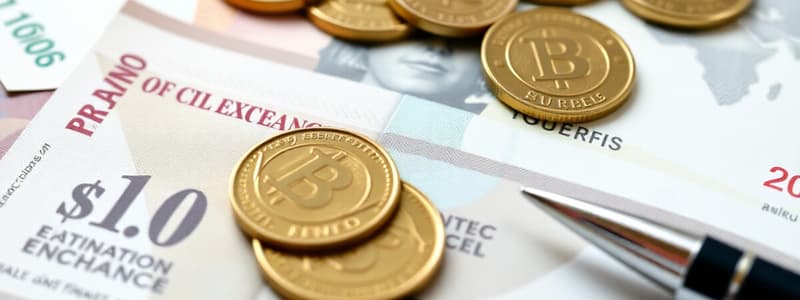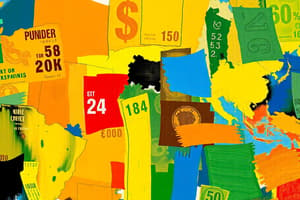Podcast
Questions and Answers
What is the role of the drawee in a bill of exchange?
What is the role of the drawee in a bill of exchange?
- To issue the bill of exchange
- To provide consent to pay as per the drawer's order (correct)
- To endorse the bill to the beneficiary
- To transfer the bill to another party
Which of the following statements is true regarding transferability of a bill of exchange?
Which of the following statements is true regarding transferability of a bill of exchange?
- It must be payable to order or to bearer (correct)
- A bill of exchange must be signed by the beneficiary to be transferable
- It must have marks that indicate non-negotiable status
- The drawer can prevent transfer to a bearer
What happens if the drawee dishonors the draft of a bill of exchange?
What happens if the drawee dishonors the draft of a bill of exchange?
- The bill becomes void
- The drawee must pay the beneficiary directly
- Any prior endorser or the drawer must make the payment (correct)
- The payment is canceled
In a bill of exchange, who is referred to as the endorser?
In a bill of exchange, who is referred to as the endorser?
Which method of payment identifies the drawee as the issuing bank?
Which method of payment identifies the drawee as the issuing bank?
What is a key feature of a bill of exchange in terms of legal protection?
What is a key feature of a bill of exchange in terms of legal protection?
What is indicated by a blank endorsement on a bill of exchange?
What is indicated by a blank endorsement on a bill of exchange?
Who is the beneficiary in the context of a bill of exchange?
Who is the beneficiary in the context of a bill of exchange?
What must be true for a bill of exchange to be classified as a negotiable instrument?
What must be true for a bill of exchange to be classified as a negotiable instrument?
What is the primary purpose of a bill of exchange?
What is the primary purpose of a bill of exchange?
Which of the following governs bills of exchange in the UK?
Which of the following governs bills of exchange in the UK?
Under the law, what is required for a date included in a bill of exchange to be considered determinable?
Under the law, what is required for a date included in a bill of exchange to be considered determinable?
What does the Law on Negotiable Instruments in Vietnam cover regarding bills of exchange?
What does the Law on Negotiable Instruments in Vietnam cover regarding bills of exchange?
Which convention affects nations that have signed the relevant agreement concerning bills of exchange?
Which convention affects nations that have signed the relevant agreement concerning bills of exchange?
Which of the following statements is true regarding the nature of a bill of exchange?
Which of the following statements is true regarding the nature of a bill of exchange?
In the context of international trade, when is a bill of exchange typically used?
In the context of international trade, when is a bill of exchange typically used?
What role does the bill of exchange play in the financing transactions?
What role does the bill of exchange play in the financing transactions?
What is a common misconception regarding the timing of payment in a bill of exchange?
What is a common misconception regarding the timing of payment in a bill of exchange?
Which of the following statements best describes the relationship under the Law on Negotiable Instruments regarding parties involved?
Which of the following statements best describes the relationship under the Law on Negotiable Instruments regarding parties involved?
Flashcards are hidden until you start studying
Study Notes
Bill Of Exchange
- Most common international payment instrument
- Unconditional, written order from one person (drawer) to another (drawee), signed by the drawer, requiring the drawee to pay on demand or at a determined future time a set sum of money to a specific person (beneficiary) or bearer (anyone holding the bill)
Governing Laws
- Geneva Convention Providing a Uniform Law for Bills of Exchange and Promissory Notes (1930)
- Affects nations that signed the convention
- Bills of Exchange Act 1882 (UK)
- Article 3 of the Uniform Commercial Code (US)
- Law on Negotiable Instruments (Vietnam, 2005)
Parties Involved
- Drawer: The person ordering the payment. Usually the seller/exporter.
- Drawee: The person obliged to pay.
- Under a Letter of Credit: The issuing bank.
- With other methods: The importer.
- Beneficiary: The person who receives payment. Usually the seller/exporter, but can be another party designated by the drawer.
- Others:
- Endorser: The person who transfers the bill to another by writing their signature on the back.
- Endorsee: The person to whom the bill is transferred.
- Acceptor: The drawee who agrees to pay by signing the bill.
- Holder: The person in possession of the bill, who is legally entitled to receive payment.
Key Features
- Transferability:
- B/E must be payable to order or bearer to be considered a negotiable instrument.
- Transfer should be done through proper endorsement ("pay to order" draft), handover/delivery with blank endorsement, or blank endorsement for bearer drafts.
- Legal Protection of Payment:
- B/E is an order to pay, not a request.
- Drawee cannot refuse payment unless they prove the B/E is illegal.
- If the drawee dishonors the draft, the payment must be made by the drawer or a prior endorser.
Studying That Suits You
Use AI to generate personalized quizzes and flashcards to suit your learning preferences.




